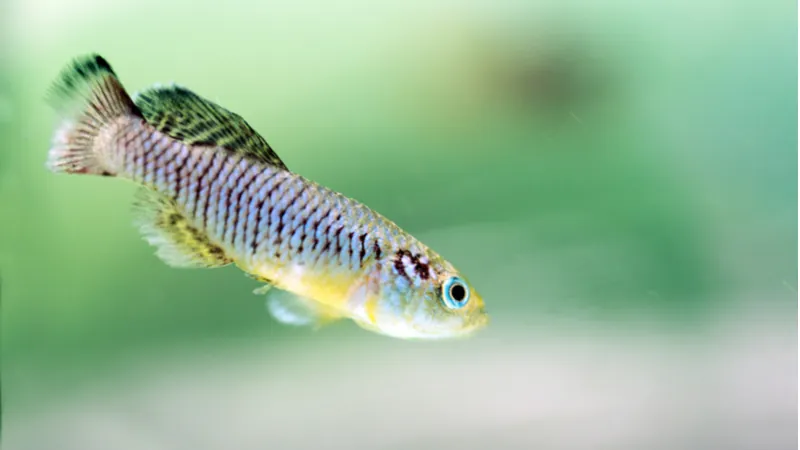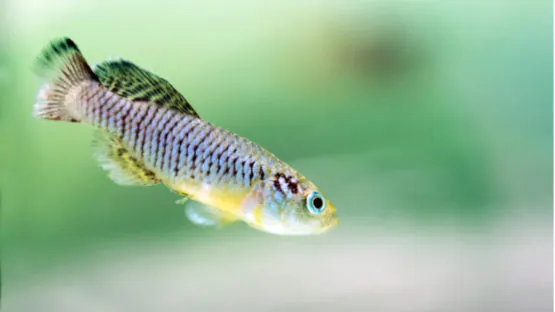A recent study published in Biogerontology has discovered a potential new aging biomarker and longevity therapeutic target [1].
Isthmin 1 (Ism1) in aging fish
Ism1 is not a well-known protein, but it has been shown to play a role in multiple aspects of biology. It contributes to tumor suppression [2,3], is essential during organ development [4], is found in high quantities in barrier tissues [5], is active in parts of the immune response [6], and improves glucose tolerance and insulin sensitivity [7].
Despite its broad range of effects in aging-adjacent fields such as cancer, immune function, and diabetes, Ism1 has not previously been investigated with respect to aging. Scientists at the Ocean University of China have recently investigated the protein both as an aging biomarker and a potential therapeutic target.
The researchers used Nothobranchius guentheri, a short-lived species of killifish, as the primary model organism for this study. In aging research, Nothobranchius guentheri has been utilized due to its small size, short lifespan, and similarity to mammalian species relative to other fish.
Ism1 may be a biomarker of aging
In this fish species, Ism1 markedly declined from 6 to 9 months of age (n=6). This was also true at the organ level, declining with age in all 11 tissues investigated. Compared to a control group, Ism1 levels were positively impacted by salidroside treatment and temperature reduction, both of which were previously shown to extend healthspan and lifespan in this species [8,9].
This prompted the researchers to conduct similar experiments in the sera of mice and humans. Ism1 declined in the sera of mice from 15 to 22 months of age (n=8) and in the sera of humans from 30 to 70 years of age (n=16). These results are consistent with what might be expected from a biomarker of biological aging.
Ism1 treatment prolonged longevity in fish
To test whether Ism1 treatment might benefit the longevity of these fish, the researchers first developed a recombinant Ism1 protein from E. coli bacteria. The recombinant Ism1 was then confirmed to be in the bloodstreams of the fish shortly after consumption.
The oral treatment increased maximum lifespan by 7.2% (from 51.5 to 55.2 weeks) and mean lifespan by 7.5% (from 45.4 to 48.8 weeks). Two aging biomarkers, SA-ß-gal and lipofuscin staining, were also significantly reduced in the tissues of treated fish. Oxidative stress was improved by Ism1 treatment as measured by multiple biomarkers, including reduced reactive oxygen species (ROS), reduced protein oxidation and lipid peroxidation, and an increase in the antioxidant enzymes SOD, GPX, and CAT.
In summary, this study highlights the identification of Isthmin1 as a new age-related biomarker and its potential rejuvenation capacity. It also shows that Ism1 may exert its rejuvenation capacity via enhancement of the activities of antioxidant enzymes SOD, GPX and CAT.
Conclusion
It is encouraging that Ism1 protein levels were similarly reduced in aged fish, mice, and humans. However, in order to be used as a biomarker of biological aging, more than two time points for each species will be needed to understand the dynamics of its changes across lifespan. Additionally, a greater number of samples will be needed to better quantify the distribution and variation of Ism1 across individuals within a species.
Similarly, the increases in healthspan and lifespan with recombinant Ism1 treatment were very encouraging. Caution is always wise when trying to project findings like this into humans, but this is especially true for studies in fish, which evolutionarily are even further from humans than mice. Still, the data presented in this study is very convincing that plays a role in the aging of these fish. It opens a wide range of future research surrounding the pathways involved in Ism1’s role in aging, both in fish and other species.
Literature
[1] Li, C., Song, L., Zhou, Y. et al. Identification of Isthmin1 in the small annual fish, Nothobranchius guentheri, as a novel biomarker of aging and its potential rejuvenation activity. Biogerontology (2022). https://doi.org/10.1007/s10522-021-09948-5
[2] Kao, C. et al. Proapoptotic cyclic peptide BC71 targets cell-surface GRP78 and functions as an anticancer therapeutic in mice. EBioMedicine (2018). https://doi.org/10.1016/j.ebiom.2018.06.004
[3] Wang, Y.G., et al. hsa_circ_0091570 acts as a ceRNA to suppress hepatocellular cancer progression by sponging hsa-miR-1307. Cancer Lett (2019). https://doi.org/10.1016/j.canlet.2019.06.007
[4] Osorio, L., Wu, X., and Zhou, Z. Distinct spatiotemporal expression of ISM1 during mouse and chick development. Cell Cycle (2014). https://doi.org/10.4161/cc.28494
[5] Valle-Rios, R. et al. Isthmin 1 is a secreted protein expressed in skin, mucosal tissues, and NK, NKT, and th17 cells. J Interferon Cytokine Res (2014). https://doi.org/10.1089/jir.2013.0137
[6] Li, C. et al. Zebrafish Ism1 is a novel antiviral factor that positively regulates antiviral immune responses. Dev Comp Immunol (2021). https://doi.org/10.1016/j.dci.2021.104210
[7] Jiang, Z. et al. Isthmin-1 is an adipokine that promotes glucose uptake and improves glucose tolerance and hepatic steatosis. Cell Metab (2021). https://doi.org/10.1016/j.cmet.2021.07.010
[8] Wang, X. et al. Time dependent effects of late-onset dietary intake of salidroside on lifespan and age-related biomarkers of the annual fish Nothobranchius guentheri. Oncotarget (2018). https://doi.org/10.18632/oncotarget.23957
[9] Wang, X. et al. Late-onset temperature reduction can retard the aging process in aged fish via a combined action of an anti-oxidant system and the insulin/insulin-like growth factor 1 signaling pathway. Rejuvenation Res (2014). https://doi.org/10.1089/rej.2014.1581




